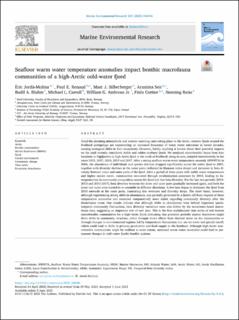| dc.contributor.author | Jorda Molina, Eric | |
| dc.contributor.author | Renaud, Paul Eric | |
| dc.contributor.author | Silberberger, Marc J. | |
| dc.contributor.author | Sen, Arunima | |
| dc.contributor.author | Bluhm, Bodil | |
| dc.contributor.author | Carroll, Michael Leslie | |
| dc.contributor.author | Ambrose, William | |
| dc.contributor.author | Cottier, Finlo Robert | |
| dc.contributor.author | Reiss, Henning | |
| dc.date.accessioned | 2023-08-24T06:14:07Z | |
| dc.date.available | 2023-08-24T06:14:07Z | |
| dc.date.created | 2023-06-26T09:30:47Z | |
| dc.date.issued | 2023 | |
| dc.identifier.citation | Jordà-Molina, E., Renaud, P. E., Silberberger, M. J., Sen, A., Bluhm, B. A., Carroll, M. L., Ambrose Jr., W. G., Cottier, F., & Reiss, H. (2023). Seafloor warm water temperature anomalies impact benthic macrofauna communities of a high-Arctic cold-water fjord. Marine Environmental Research, 189, Article 106046. doi: | en_US |
| dc.identifier.issn | 1879-0291 | |
| dc.identifier.uri | https://hdl.handle.net/11250/3085513 | |
| dc.description.abstract | Amid the alarming atmospheric and oceanic warming rates taking place in the Arctic, western fjords around the Svalbard archipelago are experiencing an increased frequency of warm water intrusions in recent decades, causing ecological shifts in their ecosystems. However, hardly anything is known about their potential impacts on the until recently considered stable and colder northern fjords. We analyzed macrobenthic fauna from four locations in Rijpfjorden (a high-Arctic fjord in the north of Svalbard) along its axis, sampled intermittently in the years 2003, 2007, 2010, 2013 and 2017. After a strong seafloor warm water temperature anomaly (SfWWTA) in 2006, the abundance of individuals and species richness dropped significantly across the entire fjord in 2007, together with diversity declines at the outer parts (reflected in Shannon index drops) and increases in beta diversity between inner and outer parts of the fjord. After a period of three years with stable water temperatures and higher sea-ice cover, communities recovered through recolonization processes by 2010, leading to homogenization in community composition across the fjord and less beta diversity. For the last two periods (2010-2013 and 2013-2017), beta diversity between the inner and outer parts gradually increased again, and both the inner and outer sites started to re-assemble in different directions. A few taxa began to dominate the fjord from 2010 onwards at the outer parts, translating into evenness and diversity drops. The inner basin, however, although experiencing strong shifts in abundances, was partially protected by a fjordic sill from impacts of these temperature anomalies and remained comparatively more stable regarding community diversity after the disturbance event. Our results indicate that although shifts in abundances were behind important spatio-temporal community fluctuations, beta diversity variations were also driven by the occurrence-based macrofauna data, suggesting an important role of rare taxa. This is the first multidecadal time series of soft-bottom macrobenthic communities for a high-Arctic fjord, indicating that potential periodic marine heatwaves might drive shifts in community structure, either through direct effects from thermal stress on the communities or through changes in environmental regimes led by temperature fluctuations (i.e. sea ice cover and glacial runoff, which could lead to shifts in primary production and food supply to the benthos). Although high-Arctic macrobenthic communities might be resilient to some extent, sustained warm water anomalies could lead to permanent changes in cold-water fjordic benthic systems. | en_US |
| dc.language.iso | eng | en_US |
| dc.publisher | Elsevier | en_US |
| dc.rights | Navngivelse 4.0 Internasjonal | * |
| dc.rights.uri | http://creativecommons.org/licenses/by/4.0/deed.no | * |
| dc.title | Seafloor warm water temperature anomalies impact benthic macrofauna communities of a high-Arctic cold-water fjord | en_US |
| dc.type | Peer reviewed | en_US |
| dc.type | Journal article | en_US |
| dc.description.version | publishedVersion | en_US |
| dc.rights.holder | © 2023 The Authors | en_US |
| dc.source.pagenumber | 18 | en_US |
| dc.source.volume | 189 | en_US |
| dc.source.journal | Marine Environmental Research | en_US |
| dc.identifier.doi | 10.1016/j.marenvres.2023.106046 | |
| dc.identifier.cristin | 2157774 | |
| dc.relation.project | The Research Council of Norway: 276730 | en_US |
| dc.relation.project | The Research Council of Norway: 228107 | en_US |
| dc.relation.project | The Research Council of Norway: 150356 | en_US |
| dc.source.articlenumber | 106046 | en_US |

